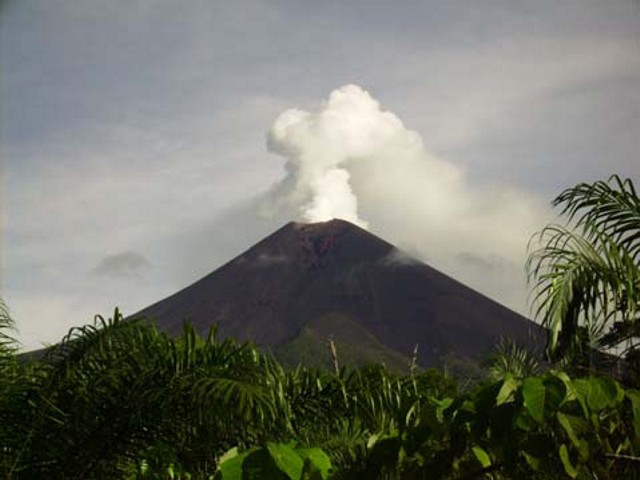Report on Ulawun (Papua New Guinea) — February 2010
Bulletin of the Global Volcanism Network, vol. 35, no. 2 (February 2010)
Managing Editor: Richard Wunderman.
Ulawun (Papua New Guinea) Steam plumes (with some possible ash) in February 2010
Please cite this report as:
Global Volcanism Program, 2010. Report on Ulawun (Papua New Guinea) (Wunderman, R., ed.). Bulletin of the Global Volcanism Network, 35:2. Smithsonian Institution. https://doi.org/10.5479/si.GVP.BGVN201002-252120
Ulawun
Papua New Guinea
5.05°S, 151.33°E; summit elev. 2334 m
All times are local (unless otherwise noted)
A Rabaul Volcano Observatory (RVO) report noted steam plumes (figure 13) and increased seismicity at Ulawun during February 2010. Some of the mid-February plumes may have contained ash. As late as October 2009, Ulawun was generally quiet except for modest seismicity (BGVN 34:10).
 |
Figure 13. Ulawun issuing passive steaming as seen from the SE side in this undated photo. RVO described this as "moderate volumes of white vapor from the summit crater." From Arumba (2009). |
A government report written in October 2009 mentioning Ulawun (Arumba, 2009) summarized activity during 2008 as generally quiet, but noted it had changed "with the commencement and continuation of high frequency volcano-tectonic earthquakes from about March [2008] onwards."
The increase in the seismicity was slight and took place during the second half of February 2010. RVO noted that during 12-27 February, Ulawun emitted steam, sometimes forcefully. There was no audible noise and no glow visible from the crater at night. According to the Darwin Volcanic Ash Advisory Centre, the plumes seen during 14-15 February 2010 may have contained ash. They reached 2.4-3.7 km altitude and drifted 45-95 km NNE.
RVO noted a further increase in the seismicity during 19-24 February, with overlapping tremor events and an increase in RSAM (Real-time Seismic-Amplitude Measurement). Volcano-tectonic earthquakes were recorded on 1, 3, 7, 8, 17, and 24 February, with daily totals ranging between 1 and 5. Low-frequency earthquakes were recorded almost every day, with daily totals between 201 and 646.
A check of MODVOLC thermal alerts in mid-April 2010 found no anomalies for Ulawun as far back as May 2001. Those 2001 alerts corresponded with new vents and large plumes in early 2001 (BGVN 26:05, 26:06). A few months earlier, observers had seen Strombolian eruptions (BGVN 25:11).
Reference. Arumba, J., 2009, Agenda Item 3, Coordinating Committee for Geoscience Programmes in East and Southeast Asia (CCOP), 46th CCOP Annual Session, 18-23 October 2009, Vungtau, Vietnam; Member Country Report of Papua New Guinea, October 2009, Annual member country report, 16 p.
Geological Summary. The symmetrical basaltic-to-andesitic Ulawun stratovolcano is the highest volcano of the Bismarck arc, and one of Papua New Guinea's most frequently active. The volcano, also known as the Father, rises above the N coast of the island of New Britain across a low saddle NE of Bamus volcano, the South Son. The upper 1,000 m is unvegetated. A prominent E-W escarpment on the south may be the result of large-scale slumping. Satellitic cones occupy the NW and E flanks. A steep-walled valley cuts the NW side, and a flank lava-flow complex lies to the south of this valley. Historical eruptions date back to the beginning of the 18th century. Twentieth-century eruptions were mildly explosive until 1967, but after 1970 several larger eruptions produced lava flows and basaltic pyroclastic flows, greatly modifying the summit crater.
Information Contacts: Ima Itikarai, Rabaul Volcano Observatory (RVO), P.O. Box 386, Rabaul, Papua New Guinea; Darwin Volcanic Ash Advisory Centre (VAAC), Commonwealth Bureau of Meteorology, Northern Territory Regional Office, PO Box 40050, Casuarina, NT 0811, Australia (URL: http://www.bom.gov.au/info/vaac/); Hawai'i Institute of Geophysics and Planetology (HIGP) Thermal Alerts System, School of Ocean and Earth Science and Technology (SOEST), Univ. of Hawai'i, 2525 Correa Road, Honolulu, HI 96822, USA (URL: http://modis.higp.hawaii.edu/).

